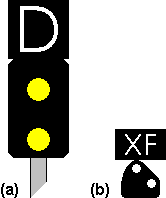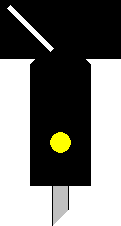|
|
|
|
|
|
|
On the LMS, a miniature green signal (see [4.89]) could be provided to the left-hand or right-hand side of a main signal. In some cases, two miniature green signals could be provided on the same side, for route indicating purposes. Where this occurred, each miniature green signal was provided with a miniature red aspect to be illuminated when the green light was extinguished [6.55], for the purpose of distinguishing which signal had cleared. |
|
A stencil type route indicator (see [6.20]) mounted on a short post was installed alongside the Up Main line at the north end of Peterborough station (Eastern Region) in April 1957 to display advance routeing information. No indication was shown unless the two signals beyond on the Up Main line, namely the Up Home and Up Main Starting signals for Crescent Junction signal box, were both 'off'. The Up Home signal was a colour light junction signal and the Up Main Starting signal was a semaphore junction signal. An "M" indication was shown in the route indicator when the Up Home and Up Main Starting signals were both cleared for a movement along the Up Main, and a "G" indication was shown when the Up Home signal was cleared for a route along the Up Main and the Up Main Starting signal was cleared for a route to the Up Goods line.
The speed signalling junction signals at Mirfield (see [6.33 - 6.35]) had their red marker lights removed in March 1962 [6.56 - 6.58]. Reducing the number of red lights in the 'stop' aspect from three to two [6.56] made it consistent with the 'stop' aspect shown by the other colour light signals in the Mirfield area (see [2.118]). The signals were abolished in May 1970 when the area was resignalled with conventional colour light signals.
 |
 |
 |
|
[6.56] Speed Signalling Junction Signal displaying a 'stop' aspect.
Area: Mirfield Usage: Medium Status: Historical |
[6.57] Speed Signalling Junction Signal cleared for main high-speed route (e.g. 'clear').
Area: Mirfield Usage: Medium Status: Historical |
[6.58] Speed Signalling Junction Signal cleared for medium-speed route (e.g. 'pass next signal at restricted speed').
Area: Mirfield Usage: Medium Status: Historical |
|---|
Discussions took place in the early 1960s with a view to selecting one form of position light junction indicator as standard for use across all the British Railways regions. While the Motive Power Committee considered that the five-lamp type (see [6.54]) was the more effective option, the S&T Committee's preference was for the cheaper and simpler three-lamp indicator (see [6.50]). The five-lamp junction indicator was finally accepted as standard, although the Southern Region continued to install the three-lamp type until around 1967, the last example of which was abolished in March 2016.
The arrival of fibre-optic signal technology in the early 1980s led to the introduction of a new form of route indicator to replace both the theatre type (see [6.25]) and stencil type (see [6.20]) indicators. There are two sizes, known as 'standard' and 'miniature' [6.60]. Standard indicators are usually associated with main signals, while miniature indicators are usually associated with shunting or subsidiary signals. Route indicators that display characters are now known generically as 'alphanumeric' route indicators, regardless of the technology used. Fibre-optic technology in alphanumeric route indicators subsequently gave way to LED lighting.
In March 1985, signal PN249 at Lancaster was provided with an experimental type of fibre-optic route indicator, which was subsequently fitted to several signals in the Crewe resignalling scheme later in the same year. A fibre-optic indicator, appropriately offset to the left or right of the main aspect, could display a rectangular bar of white light at the angle required to represent a junction indication [6.61]. The same indicator could display an alphanumeric route indication if required for other routes. Further route indicators of this type were provided on signals P423 and P468 at Peterborough in 1987; these were removed in 1989.
 |
 |
|
[6.60] Alphanumeric Route Indicator ( (a) - Standard Indicator; (b) - Miniature Indicator ).
Area: All Areas Usage: High Status: Current |
[6.61] Junction Indicator displaying a bar of light (e.g. Position 1).
Area: All Areas Usage: High Status: Current |
|---|
Colour light splitting distant signals were re-introduced as a current feature of British signalling practice in 1992, having been discontinued upon the introduction of flashing yellow aspects (see [2.132 & 2.133]). Concurrent with their re-introduction, a new type of indicator emerged known as a 'preliminary route indicator' (PRI). A PRI was to be installed some distance on approach to a colour light splitting distant signal in a four-aspect signalled area, in situations where serious operational inconvenience and delay would occur if a train was wrongly routed at the junction. The PRI is blank when the splitting distant signal ahead is showing either a 'danger' aspect, or a 'caution' aspect in each head. When the splitting distant signal shows an aspect better than single yellow in one of its heads (and the junction signal is therefore displaying a 'proceed' aspect), the PRI will exhibit a white arrow indication. If the junction signal is cleared for the highest speed route (without a junction indicator being displayed), the PRI will display a vertical arrow [6.62]. When the junction signal shows a 'proceed' aspect together with a junction indication, the PRI will display an arrow pointing in the same direction as that junction indicator [6.63].
 |
 |
[6.62] Preliminary Route Indicator (junction signal ahead cleared for straight route).

Area: All Areas Usage: Medium Status: Current |
[6.63] Preliminary Route Indicator (e.g. junction signal ahead cleared with Position 3 junction indicator).

Area: All Areas Usage: Medium Status: Current |
|---|
A PRI had been provided on a trial basis on the Down Main line between Southall and Hayes (Western Region) in November 1991, and drivers were instructed to disregard its indications. This PRI was brought into active use in May 1997 when Airport Junction (for the new line to Heathrow Airport) was commissioned, but it was only capable of showing a vertical arrow until later that year. By that time, the PRI was regarded as obsolescent, and although it seemed likely that no more would ever be installed, this turned out not to be the case.
|
In October 1994, an experimental alteration was made to the junction indicators on two signals approaching Exeter St. David's station (signal E35 on the Up Main and signal E56 on the Down Main). As an aid to determining the direction of an illuminated junction indication, the 'pivot' lights on both indicators were fitted with a blue lens; thus, an illuminated junction indication appeared as one blue light and four white lights [6.64]. The blue pivot lights were removed and the standard white lights reinstated in October 1995. |
|
A number of changes were made in 1996 to the principles concerning colour light splitting distant signals, including a requirement that a splitting distant signal reading up to a junction signal at 'danger' will display just one single yellow aspect (see [2.106]), rather than one in each head (see [6.59]).
|
Another of the 1996 principles changes provided for the introduction of distinctive aspects to be displayed by outer splitting distant signals. Although previous installations had sometimes necessitated that two consecutive signals on the approach to a junction signal were equipped as colour light splitting distant signals to give drivers earlier routeing information, both the inner and outer signals displayed similar aspects when cleared (including a single yellow aspect in at least one head of each signal). Thus, the aspect displayed by the outer splitting distant signal could be identical to that displayed by the inner splitting distant. The revised principles stated that the outer splitting distant will display a double yellow aspect when the inner splitting distant is displaying single yellow and the junction signal is at red (i.e. a normal four-aspect sequence). When the junction signal is cleared, the outer splitting distant signal will show a green aspect in one head and double yellow in the other [6.65]. The green aspect is on the side corresponding to the direction of route that is set for the train, and the aspects are stepped in height according to the relative speeds. The first outer splitting distant signal conforming to the revised principles was introduced in September 2015, on the approach to Bicester South Junction (signal number ME353). |
|
Although the introduction of the outer splitting distant signal had been expected to make the preliminary route indicator (see [6.62 & 6.63]) redundant, further examples of these were installed but used in different circumstances. Two PRIs were provided on the approach to Saltwood Junction in September 2002, but unlike the earlier installation at Airport Junction, no splitting distant signal was involved in the junction signalling arrangement. The PRIs supplement a compliant junction signalling arrangement, conveying advance routeing information for the sole purpose of preventing mis-routeing of trains. A number of similar installations have since been made, and their provision is not necessarily confined to four-aspect signalling territory. When provided in four-aspect territory, two PRIs in succession are normally placed on the approach to the junction. A PRI will only display an indication when the relevant junction signal is displaying a 'proceed' aspect and, where applicable, any signal situated between the PRI and the junction signal is also displaying a 'proceed' aspect.
To comply with the existing standard, the first junction indicators to use LED clusters instead of filament lamps had perpetuated the traditional 'position light' appearance (see [6.54]). A new form of LED junction indicator, which displays a solid bar of white light in each arm (see [6.61]) instead of five individual lights, went on trial in August 2010 at Pelaw (signal number T49) and was subsequently accepted for general use.
|
|